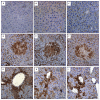Activation of IFN-γ/STAT/IRF-1 in hepatic responses to Klebsiella pneumoniae infection
- PMID: 24223208
- PMCID: PMC3819302
- DOI: 10.1371/journal.pone.0079961
Activation of IFN-γ/STAT/IRF-1 in hepatic responses to Klebsiella pneumoniae infection
Abstract
Background: Klebsiella pneumoniae-caused liver abscess (KLA) has become a health problem in Taiwan and is continually reported in other countries. Diabetes mellitus, the most common metabolic disorder, underlies half of the KLA patients in Taiwan. The clinical impact of KLA has been well-documented. Nevertheless, the molecular basis regarding how K. pneumoniae causes liver infection, particularly in diabetic individuals, remains unclear.
Methodology/principle findings: Auto-bioluminescence-expressing K. pneumoniae was inoculated into diabetic mice and age-match naïve control. With the use of in vivo imaging system, translocation of the bioluminescence-expressing K. pneumoniae from intestine to extraintestinal organs, mainly the liver, was noted in 80% of the diabetic mice, whereas the same bacteria causes extraintestinal infections in only 31% of naïve mice. Besides increased morbidity, the severity of hepatic tissue injury was also enhanced in the K. pneumoniae-infected diabetic mice. Upon K. pneumoniae infection, IFN-γ production was significantly evoked in the liver. To mediate IFN-γ signal, STAT (signal transducers and activators of transcription) 1 and 3 were activated in hepatocytes, and so was the expression of IRF (interferon regulatory factor)-1. Moreover, accumulation of neutrophils which was triggered by prolonged production of IL-1β and MIP-2, and significant increases in the level of active caspase 3 and phospho-eIF2α, were exclusively revealed in the K. pneumoniae-infected diabetic mice.
Conclusion: The activation of IFN-γ/STAT/IRF-1 signaling demonstrated by this work emphasizes the role of IFN-γ for mediating the hepatic response to K. pneumoniae infection.
Conflict of interest statement
Figures







Similar articles
-
IL-23 mediates murine liver transplantation ischemia-reperfusion injury via IFN-γ/IRF-1 pathway.Am J Physiol Gastrointest Liver Physiol. 2018 Dec 1;315(6):G991-G1002. doi: 10.1152/ajpgi.00231.2018. Epub 2018 Oct 11. Am J Physiol Gastrointest Liver Physiol. 2018. PMID: 30307739 Free PMC article.
-
Comparison of Diabetic and Non-diabetic Human Leukocytic Responses to Different Capsule Types of Klebsiella pneumoniae Responsible for Causing Pyogenic Liver Abscess.Front Cell Infect Microbiol. 2017 Sep 7;7:401. doi: 10.3389/fcimb.2017.00401. eCollection 2017. Front Cell Infect Microbiol. 2017. PMID: 28936426 Free PMC article.
-
SKAP2 is required for defense against K. pneumoniae infection and neutrophil respiratory burst.Elife. 2020 Apr 30;9:e56656. doi: 10.7554/eLife.56656. Elife. 2020. PMID: 32352382 Free PMC article.
-
Divergent role of gamma interferon in a murine model of pulmonary versus systemic Klebsiella pneumoniae infection.Infect Immun. 2002 Nov;70(11):6310-8. doi: 10.1128/IAI.70.11.6310-6318.2002. Infect Immun. 2002. PMID: 12379710 Free PMC article.
-
Pyogenic liver abscess with a focus on Klebsiella pneumoniae as a primary pathogen: an emerging disease with unique clinical characteristics.Am J Gastroenterol. 2005 Feb;100(2):322-31. doi: 10.1111/j.1572-0241.2005.40310.x. Am J Gastroenterol. 2005. PMID: 15667489 Review.
Cited by
-
Host Immune Response to Clinical Hypervirulent Klebsiella pneumoniae Pulmonary Infections via Transcriptome Analysis.J Immunol Res. 2022 Sep 20;2022:5336931. doi: 10.1155/2022/5336931. eCollection 2022. J Immunol Res. 2022. PMID: 36249423 Free PMC article.
-
STAT1 Employs Myeloid Cell-Extrinsic Mechanisms to Regulate the Neutrophil Response and Provide Protection against Invasive Klebsiella pneumoniae Lung Infection.Immunohorizons. 2024 Jan 1;8(1):122-135. doi: 10.4049/immunohorizons.2300104. Immunohorizons. 2024. PMID: 38289252 Free PMC article.
-
Alterations of gut microbiota in cirrhotic patients with spontaneous bacterial peritonitis: A distinctive diagnostic feature.Front Cell Infect Microbiol. 2022 Sep 6;12:999418. doi: 10.3389/fcimb.2022.999418. eCollection 2022. Front Cell Infect Microbiol. 2022. PMID: 36147601 Free PMC article.
-
A fragment of the alarmin prothymosin α as a novel biomarker in murine models of bacteria-induced sepsis.Oncotarget. 2017 Jul 25;8(30):48635-48649. doi: 10.18632/oncotarget.18149. Oncotarget. 2017. PMID: 28611290 Free PMC article.
-
Immunoinformatics-Aided Design and Evaluation of a Potential Multi-Epitope Vaccine against Klebsiella Pneumoniae.Vaccines (Basel). 2019 Aug 12;7(3):88. doi: 10.3390/vaccines7030088. Vaccines (Basel). 2019. PMID: 31409021 Free PMC article.
References
Publication types
MeSH terms
Substances
LinkOut - more resources
Full Text Sources
Other Literature Sources
Research Materials

